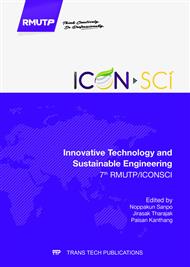p.357
p.361
p.365
p.370
p.375
p.379
p.383
p.387
p.392
Friction Tests of Ball Bearings with Comparison of Lubricants
Abstract:
The ball bearings are the rotating components which are widely spread to moving parts for all machinery operation in general industry. This paper presents the ball bearing resistance tool which has a proper size and can handle the maximum load of 300 kg by using an electric power. The ball bearing resistance tool was used to test the bearings No. 6011 cm. The series of tests was performed in the ball bearings lubricated; engine oil SAE 10W/40, auto transmission fluid Dexron, and hydraulic oil. The rotational speeds for testing were vary; 500, 600 and 700 rpm respectively. At each speed, there were various weight; 50, 70, 90,110,130,150, and 170 kg respectively. The results show that the hydraulic oil generated the smallest coefficients of friction and energy efficiency for ball bearing operation.
Info:
Periodical:
Pages:
375-378
Citation:
Online since:
June 2017
Authors:
Keywords:
Price:
Сopyright:
© 2017 Trans Tech Publications Ltd. All Rights Reserved
Share:
Citation:


